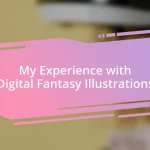Key takeaways:
- Storytelling in illustrations effectively blends visuals and narrative, using elements like color, composition, and character design to evoke emotions and provoke thoughts.
- Techniques such as juxtaposition, symbolism, and pacing enhance the narrative by engaging the viewer’s emotions and encouraging deeper reflection on the story.
- Developing characters and narrative arcs is vital, utilizing visual elements to reflect their growth and integrating secondary characters to enrich the main storyline.

Understanding storytelling in illustrations
Storytelling in illustrations is a fascinating blend of visuals and narrative that can evoke emotions and provoke thoughts simultaneously. I remember a time when I first encountered an illustration that brought tears to my eyes; it was just a simple image of a child playing in the rain, but it captured the essence of joy and sorrow in a way that words often fail to do. Have you ever felt an image speak to you, capturing a moment in a way that transcends language? That’s the power of storytelling through art.
When we analyze illustrations, it becomes clear that every line, color, and texture plays a vital role in conveying the story. For instance, I often use warm colors to evoke feelings of happiness, while cooler tones can signify melancholy. This interplay can guide the viewer’s emotions and direct their interpretation of the story being depicted. Have you noticed how certain images linger in your mind, almost as if they are whispering untold secrets? That’s an invitation to delve deeper into the story behind the illustration.
It’s also important to consider the relationship between the viewer and the illustration. I find that when I incorporate relatable characters or familiar settings, it creates a connection that pulls the audience in. Have you ever stared at an illustration and felt as though you knew the character’s story? By infusing personal experiences and universal truths into illustrations, I aim to create a narrative that resonates on a deeper level, sparking curiosity and engagement.

Elements of effective illustration
Effective illustrations rely on several key elements that work in tandem to tell a compelling story. In my experience, the interplay between composition and color is crucial. I remember a time when I experimented with asymmetrical compositions, which brought an unexpected energy to my work and led viewers to interpret the story differently. Color choices, like shadows and highlights, create depth and emphasize emotion, transforming a simple illustration into a vivid narrative.
Here are some essential elements to consider for effective illustrations:
- Composition: The arrangement of elements guides the viewer’s eye and shapes their understanding of the story.
- Color Palette: Colors evoke emotions; I often choose palettes that reflect the mood I want to convey.
- Character Design: Distinctive characters draw viewers in and create memorable connections.
- Line Quality: Varying line thickness adds texture and can signify motion or emotion.
- Background Details: The setting enhances the narrative, providing context that draws the viewer further into the scene.
When these elements are thoughtfully combined, they elevate the illustration from a static image to a dynamic story that resonates with audiences on multiple levels. I’ve often found that subtle details, like a character’s expression or a hint of movement in the background, can leave a lasting impact, encouraging viewers to linger and ponder the narrative.

Techniques for visual storytelling
The techniques used in visual storytelling are diverse yet interconnected, each playing its part in enriching the narrative. For instance, I often focus on juxtaposition, where contrasting elements create tension and intrigue. Once, I illustrated a scene where a serene landscape met a chaotic urban environment, and the stark difference made viewers stop and reflect on the themes of nature versus progress. Have you ever noticed how a striking contrast can draw you into a story, prompting deeper thought?
Another technique I cherish is the use of symbolism. I remember illustrating a character holding a wilted flower; to me, it represented lost opportunities. It’s amazing how a simple symbol can evoke layers of meaning, making the illustration resonate with personal experiences. Have you found that certain images linger in your mind because of the emotions or memories they trigger? That’s the goal of integrating symbols into your work.
Finally, pacing is crucial in visual storytelling. I often play with the rhythm of elements in my illustrations, contrasting busy areas with open spaces to guide the viewer’s eye and build anticipation. There was a time I illustrated a story about a journey, where each page varied in complexity, allowing the audience to breathe and absorb the narrative before diving into the next exciting moment. I find that this ebb and flow can create an immersive experience. Do you think about pacing when you look at illustrations, or has it ever struck you how one might feel ‘quicker’ than another?
| Technique | Description |
|---|---|
| Juxtaposition | Using contrasting elements to highlight differences and provoke thought. |
| Symbolism | Incorporating objects or elements that represent deeper meanings or themes. |
| Pacing | Varying the complexity of scenes to guide the viewer’s experience and emotional journey. |

Creating emotional connections through visuals
Creating emotional connections through visuals is something I take to heart in my illustrations. I vividly recall a project where I captured a moment of joy between a parent and child. It was their shared laughter that I aimed to illustrate, and I found that using soft, warm colors and gentle lines breathed life into that scene. Have you ever felt your heart swell while looking at an image? That’s what I strive for—moments that resonate deeply with viewers.
One of my favorite tricks is to focus on small details that reflect larger emotions. For instance, I once illustrated a character standing alone on a bustling street, with a slight smile on their face, the light capturing just the right moment. It wasn’t about the setting, but rather the contrast of the character’s emotion against the chaos surrounding them. I often reflect on the power of these subtleties; they compel the audience to dive deeper into the narrative and find their own stories within it. Do you ever find yourself drawn to images that evoke unexpected feelings?
When I think of emotional connection, I can’t overlook the role of expression in character design. There’s a specific illustration I created, showcasing a character with teary eyes and a faint smile. It struck a chord with many viewers, prompting them to share their own stories of resilience. I love how a simple expression can convey complexity and invite empathy. Isn’t it fascinating how visuals can spark emotional discourse and create a tapestry of shared experiences among viewers?

Using color and composition strategically
Using color strategically can transform an illustration from ordinary to extraordinary. I remember a time when I used vibrant reds and yellows to depict a character’s excitement in a festival scene. The bright colors immediately drew the viewer’s eye and conveyed the energy of the moment. Have you ever noticed how certain colors can evoke specific feelings almost instantly?
Composition, on the other hand, plays a critical role in guiding the viewer’s journey through the story. In one of my pieces, I arranged the elements so that the leading lines naturally drew attention to the main character. This not only highlighted their importance but also created a sense of movement and direction within the scene. Do you think about how the arrangement of visuals can steer your emotions or thoughts while viewing an illustration?
When combining color and composition, I often look for harmony that enhances the narrative. For instance, while illustrating a character facing a storm, I opted for darker hues in the background to reflect impending danger while keeping the character’s colors vibrant. This not only added depth but also emphasized their courage. It’s interesting how the careful selection of colors and the right composition can narrate such powerful stories without words, don’t you think?

Developing character and narrative arcs
Characters are at the heart of any narrative arc, and developing them involves understanding their desires, fears, and transformations. I recall creating a character who started off as timid and anxious but evolved into a confident leader by the story’s end. This journey not only required careful attention to their visual representation—gradually using bolder colors and stronger poses—but also necessitated moments of conflict where they faced their fears. Have you ever noticed how a character’s evolution can mirror our own personal growth?
When crafting a narrative arc, pacing is essential to keep the audience engaged. I once illustrated a story where a character faced multiple challenges, each one visually represented by more intense colors and dynamic angles. During these climactic scenes, I experimented with the angle of the illustrations to complement the rising tension. This combination created a sense of urgency that kept viewers eagerly turning the pages. Don’t you think pacing is crucial in making a narrative feel alive?
Additionally, I find that integrating secondary characters adds layers to the main character’s journey. For instance, in one of my projects, I illustrated a wise mentor who provided crucial guidance. The mentor’s design was subtly distinct, using cooler hues that contrasted with the protagonist’s vibrant palette. This visual dynamic reflected their roles in each other’s arcs beautifully. How often do you see secondary characters enriching the main storyline in illustrations?














